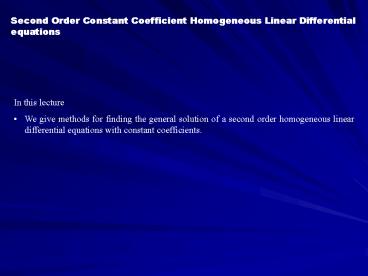Second Order Constant Coefficient Homogeneous Linear Differential equations PowerPoint PPT Presentation
1 / 32
Title: Second Order Constant Coefficient Homogeneous Linear Differential equations
1
Second Order Constant Coefficient Homogeneous
Linear Differential equations
- In this lecture
- We give methods for finding the general solution
of a second order homogeneous linear differential
equations with constant coefficients.
2
A second order homogeneous linear DE with
constant coefficients is an equation of the form
(1)
where the coefficients p and q are constants
(independent of x and y).
We want to find the general solution of such
equations. For this we shall first look at a
first order equation.
3
Look at the first order equation
We note that
is a solution.
Hence we guess a solution of the second order
equation (1) as
m a constant.
Substituting in(1) we get
4
Since
we find that m satisfies
the so called Auxiliary equation
The above is a quadratic equation in m. And so
the general solution of (1) depends on the nature
of the roots of the auxiliary equation.
5
Case (1) The Auxiliary equation has two real and
distinct roots, m1, m2 say.
and
Hence
are two solutions of (1).
They are LI as their Wronskian is
Hence the general solution of (1) is
c1, c2 are arbitrary constants.
6
Case (2) The Auxiliary equation has two real and
equal roots, m1, m1 say.
The roots m1 and m2 are equal real numbers iff
p2 4q 0.
Hence
is one solution of (1).
with
A second LI solution is y y2 v y1 where
Hence
7
Thus a second LI solution is y2 v y1
Hence the general solution of (1) is
c1, c2 are arbitrary constants.
Case (3) The Auxiliary equation has two complex
roots, say,
Hence
is a complex solution of (1).
8
Hence its real part
and its imaginary part
are two real solutions of the d.e. (1)
The Wronskian of
is
Thus y1, y2 is LI.
Hence the general solution of (1) is
c1, c2 are arbitrary constants.
9
Summary
D.E.
Auxiliary equation
m1,m2 are the roots of the Auxiliary equation
( c1, c2 are arbitrary constants)
10
Problems
Find the general Solution of
1.
i.e.
Auxiliary equation
(real and distinct)
1, -2
Roots
Thus the general solution is
( c1, c2 are arbitrary constants)
11
2. Find the general solution of
i.e.
Auxiliary equation
1, 2/3
Roots
(real and distinct)
Thus the general solution is
( c1, c2 are arbitrary constants)
12
3. Find the general solution of
i.e.
Auxiliary equation
(real and equal)
2, 2
Roots
Thus the general solution is
( c1, c2 are arbitrary constants)
13
4. Find the general solution of
i.e.
Auxiliary equation
(real and equal)
Roots
Thus the general solution is
( c1, c2 are arbitrary constants)
14
5. Find the general solution of
i.e.
Auxiliary equation
(complex)
Roots
Thus the general solution is
( c1, c2 are arbitrary constants)
15
6. Find the general solution of
i.e.
Auxiliary equation
(complex)
Roots
Thus the general solution is
( c1, c2 are arbitrary constants)
16
7. Find the solution of the initial-value problem
Given d.e. is
Auxiliary equation
(Real and distinct)
Roots
Thus the general solution is
( c1, c2 are arbitrary constants)
17
x 0 gives y
2
Differentiating the general solution, we get
x 0 gives y?
Solving we get
Thus the solution to the given problem is
18
8. Find the solution of the initial-value problem
Given d.e. is
Auxiliary equation
Roots
(Complex)
Thus the general solution is
( c1, c2 are arbitrary constants)
19
x 0 gives y
0
Differentiating the general solution, we get
x 0 gives y?
Solving we get
Thus the solution to the given problem is
20
Eulers Equidimensional equation
The second order homogeneous LDE
(p and q are constants)
is called an Eulers Equidimensional equation.
We put x ez.
21
Hence the given Eulers equation becomes
which is a constant coefficient homogeneous
l.d.e.(with z as independent variable) and hence
can be solved.
22
9. Find the general solution of
Putting x ez, the given equation becomes
Auxiliary equation
Roots
(Real and distinct)
Thus the general solution is
( c1, c2 are arbitrary constants)
23
10. Find the general solution of
Putting x ez, the given equation becomes
Auxiliary equation
Roots
(Complex)
Thus the general solution is
( c1, c2 are arbitrary constants)
24
Problem 6 (page 98) Consider the general
homogeneous equation change the independent
variable from x to z z(x), where z(x) is an
unspecified function of x. Show that (1) can be
transformed in this way into an equation with
constant coefficient if and only if
is constant, in which case
will effect the desired result.
25
Let
where P(x) and Q(x) are function of x and let
independent variable be changed from x to z
z(x).
and
Substituting in (1) we get
26
... (2)
where
Let
27
(No Transcript)
28
Thus, Eq (2) can be solved if and only if
Now
29
Problem 7, (Page 98) Solve
Solution
Compare the given eqn with
30
We choose z such that
Now changing the independent variable from x to
z, by using the above given relation the given
eqn is transformed into
31
Where
Solve the above eqn we get
32
Solve the DE
Solution is not possible by the above method,
because p1 is not constant.

